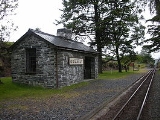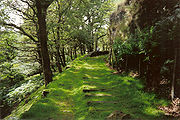
Dduallt railway station
Encyclopedia
Dduallt station is a passenger station on the narrow gauge Ffestiniog Railway
in northwest Wales
, which was built in 1836 to carry dressed slate from Blaenau Ffestiniog
to Porthmadog
for export by sea.
Dduallt is at a height of 540 feet (164.6 m) and a distance of just over 9.5 miles (15.3 km) from Porthmadog.
station (although up goods trains are said to have been required to stop at Dduallt for examination prior to passing through Moelwyn tunnel). There has never been road access to Dduallt station, which can only be reached by public footpaths.
The quiet station at Dduallt was first mentioned as a passenger station in 1880. It was established as a signalling block post
in 1884 on the closure of Tunnel South Signal Box . It then declined steadily becoming an unstaffed halt in the 1930s (when it was landscaped by Clough Williams-Ellis
who 40 years later advised on further landscaping) until final closure to passengers on 15 September 1939. Dduallt reopened to passenger trains on 6 April 1968, although passengers could not alight at the station for another few weeks because of continuing building work. The original slate water tank was re-commissioned in May 1969 as an emergency supply and later a water supply was provided at the station, which was the upper terminus until 8 July 1977.

The land in the centre of Dduallt spiral is the knoll of a small hill and it is set out with an orienteering table as a viewing point with extensive views over the upper vale of Ffestiniog. The knoll is a popular picnic spot in the summer.
Dduallt station is operated as an unstaffed halt and trains only call on request. Intending passengers are advised to check with the Ffestiniog Railway Company before embarking on their journey.
 Dduallt was the starting point for the Ffestiniog Railway Deviation, the 2.5 miles (4 km) diversionary route built between 1965 and 1978 to bypass Tanygrisiau
Dduallt was the starting point for the Ffestiniog Railway Deviation, the 2.5 miles (4 km) diversionary route built between 1965 and 1978 to bypass Tanygrisiau
hydro-electric
power station, one of two pumped-storage schemes in Wales, and its lower reservoir (Llyn Ystradau). The Deviation (this is the conventional name for such railway works) was built mostly by volunteers and involved a 310 yards (283.5 m) long new tunnel constructed by three Cornish tin mining engineers (and some employees) between 1975 and 1977. At the southern end is the spectacular Dduallt spiral formation
constructed with its bridge entirely by volunteers to gain an initial height rise of 35 feet (10.7 m) in order (after a further mile of the new railway and the new tunnel) to clear the flooded track bed north of the former tunnel. Parts of the trackless former route can be clearly seen below the new route, particularly just north of Dduallt. The old tunnel is plugged near its northern end, which is usually underwater. Some delicate engineering work was required where the new line passes over the power station pipelines.
A pull and push
service officially called The Shuttle and powered by diesel locomotive Moel Hebog with carriage 110 was operated from Dduallt to a temporary terminus at Gelliwiog, before the new Moelwyn Tunnel, from 26 May 1975, during two summers, to enable tourists to experience the excellent views from the Deviation route, in advance of the opening of the new Moelwyn Tunnel. For several years before this an earlier Shuttle had run between Tan-y-Bwlch and Dduallt in between the regular trains in the peak period. It was hauled by diesel locomotive Moelwyn with a short train of 4 wheeled coaches.
Another temporary terminus known as "Llyn Ystradau" (now dismantled) existed alongside the reservoir during 1977, but passengers were not permitted to leave the station other than by train since it was on Central Electricity Generating Board land without public access.
Ffestiniog Railway
The Ffestiniog Railway is a narrow gauge heritage railway, located in Gwynedd, Wales. It is a major tourist attraction located mainly within the Snowdonia National Park....
in northwest Wales
Wales
Wales is a country that is part of the United Kingdom and the island of Great Britain, bordered by England to its east and the Atlantic Ocean and Irish Sea to its west. It has a population of three million, and a total area of 20,779 km²...
, which was built in 1836 to carry dressed slate from Blaenau Ffestiniog
Blaenau Ffestiniog
Blaenau Ffestiniog is a town in Gwynedd, north-west Wales. It has a population of 5,000, including Llan Ffestiniog, which makes it the third largest town in Gwynedd, behind Caernarfon & Porthmadog. Although the population reached 12,000 at the peak of the slate industry, the population fell due to...
to Porthmadog
Porthmadog
Porthmadog , known locally as "Port", and historically rendered into English as Portmadoc, is a small coastal town and community in the Eifionydd area of Gwynedd, in Wales. Prior to the Local Government Act 1972 it was in the administrative county of Caernarfonshire. The town lies east of...
for export by sea.
Dduallt is at a height of 540 feet (164.6 m) and a distance of just over 9.5 miles (15.3 km) from Porthmadog.
Station history
When steam traction was introduced on the railway in 1863, a slate water tank (which still exists) was established near Dduallt farm about 0.5 mile (0.80467 km) below the present station and all up trains stopped for water. Regular use of this facility probably ceased about 1872 with the opening of Tan-y-BwlchTan-y-Bwlch railway station
Tan-y-Bwlch station is the principal intermediate passenger station on the narrow gauge Ffestiniog Railway, which was built in 1836 to carry dressed slate from Blaenau Ffestiniog to Porthmadog for export by sea...
station (although up goods trains are said to have been required to stop at Dduallt for examination prior to passing through Moelwyn tunnel). There has never been road access to Dduallt station, which can only be reached by public footpaths.
The quiet station at Dduallt was first mentioned as a passenger station in 1880. It was established as a signalling block post
Block post
A block post in railway signalling is the signal box at one end of a block section. -German practice:In Germany block posts are known as Blockstellen and are defined as railway facilities on the open line that, as part of a block system, mark the end of a block section. The usually have a home...
in 1884 on the closure of Tunnel South Signal Box . It then declined steadily becoming an unstaffed halt in the 1930s (when it was landscaped by Clough Williams-Ellis
Clough Williams-Ellis
Sir Bertram Clough Williams-Ellis, CBE, MC was an English-born Welsh architect known chiefly as creator of the Italianate village of Portmeirion in North Wales.-Origins, education and early career:...
who 40 years later advised on further landscaping) until final closure to passengers on 15 September 1939. Dduallt reopened to passenger trains on 6 April 1968, although passengers could not alight at the station for another few weeks because of continuing building work. The original slate water tank was re-commissioned in May 1969 as an emergency supply and later a water supply was provided at the station, which was the upper terminus until 8 July 1977.

Facilities
The present buildings at Dduallt are a water supply tank (now out of use), a stone built shelter constructed by volunteers in 1998, and Rhoslyn cottage, which latter was always privately owned until bought, derelict in 2005 by the Festiniog Railway Company.The land in the centre of Dduallt spiral is the knoll of a small hill and it is set out with an orienteering table as a viewing point with extensive views over the upper vale of Ffestiniog. The knoll is a popular picnic spot in the summer.
Dduallt station is operated as an unstaffed halt and trains only call on request. Intending passengers are advised to check with the Ffestiniog Railway Company before embarking on their journey.
The Deviation

Tanygrisiau
Tanygrisiau is a village in the upper end of the Vale of Ffestiniog in the county of Gwynedd, north-west Wales . It can be found along the southern side of the Moelwyn mountain range and dates to around 1750...
hydro-electric
Pumped-storage hydroelectricity
Pumped-storage hydroelectricity is a type of hydroelectric power generation used by some power plants for load balancing. The method stores energy in the form of water, pumped from a lower elevation reservoir to a higher elevation. Low-cost off-peak electric power is used to run the pumps...
power station, one of two pumped-storage schemes in Wales, and its lower reservoir (Llyn Ystradau). The Deviation (this is the conventional name for such railway works) was built mostly by volunteers and involved a 310 yards (283.5 m) long new tunnel constructed by three Cornish tin mining engineers (and some employees) between 1975 and 1977. At the southern end is the spectacular Dduallt spiral formation
Spiral (railway)
A spiral is a technique employed by railways to ascend steep hills.A railway spiral rises on a steady curve until it has completed a loop, passing over itself as it gains height, allowing the railway to gain vertical elevation in a relatively short horizontal distance...
constructed with its bridge entirely by volunteers to gain an initial height rise of 35 feet (10.7 m) in order (after a further mile of the new railway and the new tunnel) to clear the flooded track bed north of the former tunnel. Parts of the trackless former route can be clearly seen below the new route, particularly just north of Dduallt. The old tunnel is plugged near its northern end, which is usually underwater. Some delicate engineering work was required where the new line passes over the power station pipelines.
A pull and push
Push-pull train
Push–pull is a mode of operation for locomotive-hauled trains allowing them to be driven from either end.A push–pull train has a locomotive at one end of the train, connected via some form of remote control, such as multiple-unit train control, to a vehicle equipped with a control cab at the other...
service officially called The Shuttle and powered by diesel locomotive Moel Hebog with carriage 110 was operated from Dduallt to a temporary terminus at Gelliwiog, before the new Moelwyn Tunnel, from 26 May 1975, during two summers, to enable tourists to experience the excellent views from the Deviation route, in advance of the opening of the new Moelwyn Tunnel. For several years before this an earlier Shuttle had run between Tan-y-Bwlch and Dduallt in between the regular trains in the peak period. It was hauled by diesel locomotive Moelwyn with a short train of 4 wheeled coaches.
Another temporary terminus known as "Llyn Ystradau" (now dismantled) existed alongside the reservoir during 1977, but passengers were not permitted to leave the station other than by train since it was on Central Electricity Generating Board land without public access.
External links
- The Ffestiniog Railway Company's website
- Interactive Route Map on Live.com
- Ffestiniog Railway Timetables
- Multimap Map of Dduallt

